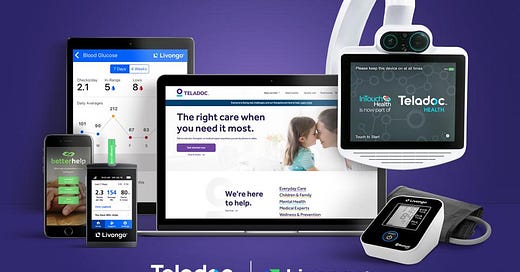A digital health star is born.
Dear friends and colleagues,
How are you? How has your start of 2021 been? Personally, my goal this year is to let go. Let go of expectations, control, and the past. Just focus on the immediate thing ahead. The next assignment to complete. The next article to write.
As the pandemic didn’t magically disappear as we woke up the morning of Jan 1, 2021, let’s talk about the thing that will impact the next decade of patient care.
Telehealth.
I don’t know about you, but I have used telehealth more times in 2020 than I have done ever. I still remember when I first got a Teladoc card, I thought to myself: “When will I ever use this? When I travel to Africa I suppose… How can a physician diagnose over a screen?” However, of all the times I used Telehealth this year, I had really good experiences.
The largest digital health deal ever
Teladoc merged with Livongo to be the first virtual health giant of $37 billion enterprise value.
Teladoc is a platform for virtual doctor visits
Livongo is a data-based health coaching program to help people manage chronic conditions
Both have seen massive growth during the Covid-19 era. Doctors saw massive increase of telehealth visits, more than 50x times higher than pre-COVID.
To put into perspective, in 2019 the sum of the valuation of Teladoc and Livongo is only ~$8B. The combined entity more than quadrupled its valuation due to COVID.
2019:
Teladoc valued at $5.2B
Livongo valued at $3.2B
Teledoc + Livongo combined = $8.5B
2020:
Livongo acquired at $18.5B valuation
Teladoc + Livongo combined entity valued at $37B
And just like that, a digital healthcare star is born. (Lady Gaga reference. Too stretching?)
How will this impact future of healthcare
COVID aside, 90% of the $4 trillion of healthcare costs are due to people with chronic and mental health conditions.
Due to the disruptions in health systems, it is more likely that a virtual platform that focus on continuous care instead of one-time treatments will be more beneficial.
Source: Teladoc Health Presentation
Teladoc sought after Livongo because Livongo has relevant patient data and ability to deliver real-time care. Livongo saw Teladoc as a threat due to Teladoc’s existing large distribution network. Over 70 million people in the US have access to Teladoc while Livongo has only 410,000 members for its diabetes program.
So what does that mean for a typical person?
Say a patient named Claire is living with high-blood pressure (simplified from Teladoc Health Presentation)
She does an annual exam with a Teladoc primary care physician.
Teladoc creates health plan including referral to Livongo high blood pressure program.
Using connected blood pressure monitor and cuff, Claire and care team monitors her high blood pressure.
Health Nudges encourages Claire to stay on track as she continues to monitor her symptoms
Based on clinical data, Teladoc physician writes Rx for blood pressure. Claire also consults a Teladoc nutritionist for diet and a Teladoc mental health therapists for her stress.
As healthcare data becomes extremely valuable, whoever owns it has a significant leverage. By owning end-to-end patient journey, Teladoc will have a closed ecosystem that excludes the hospital system, but could provide valuable patient data for the hospitals.
What are your thoughts? Will this merger enable better care through virtual platform, or will it create more barriers?
Moving digitally,
Katherine
Source: Teladoc Presentation Sept 2020: Transforming Healthcare Across the Continuum of Care https://s21.q4cdn.com/672268105/files/doc_presentations/2020/09/TDOC_LVGO_Investor-Presentation-9.3.2020.pdf





